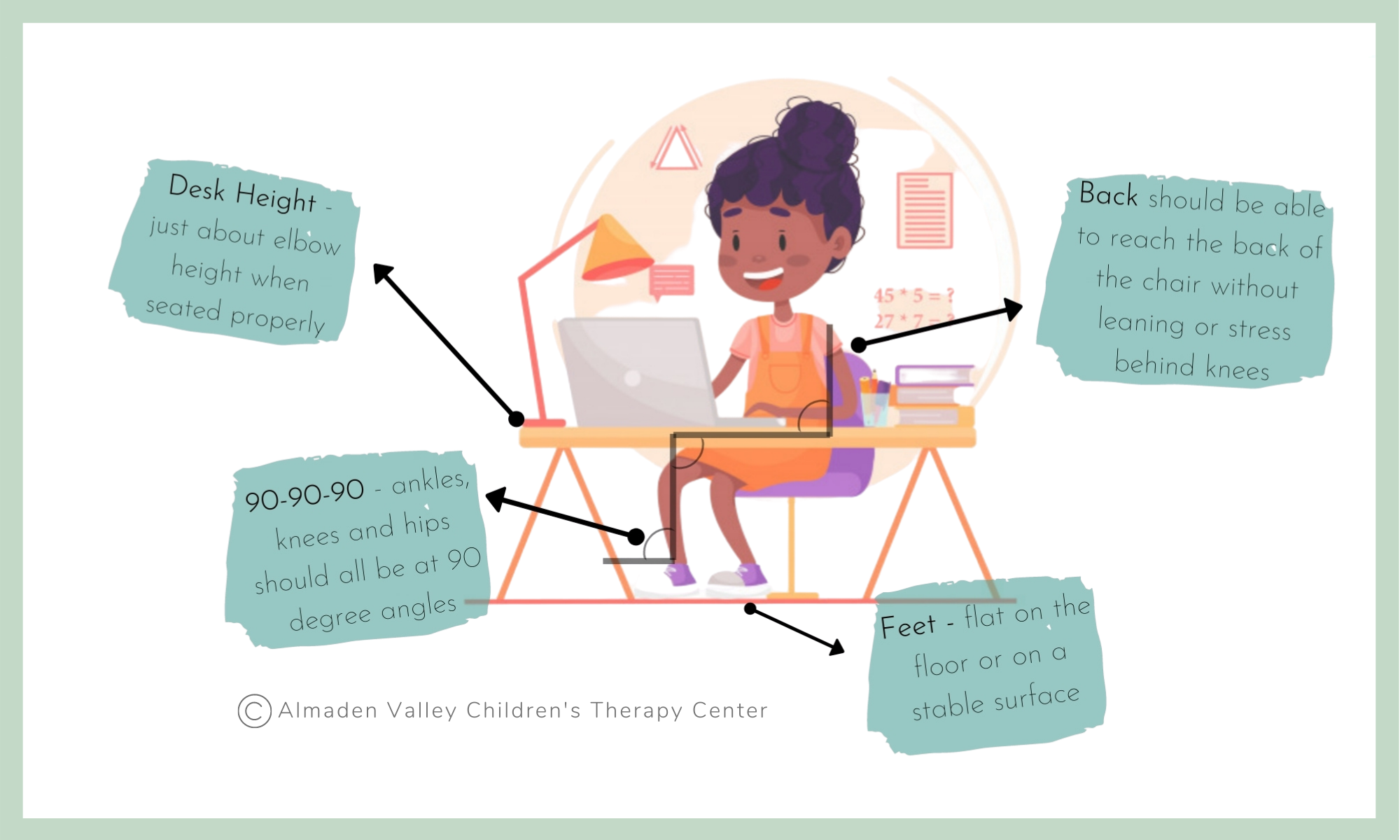Four Reasons Why Your Child Can’t Sit Still
by Brittney Weinerth MS, OTR/L
Back in 2014, an Occupational Therapist named Angela Hanscom wrote an article for The Washington Post that described why so many kids can’t sit still nowadays and the post went viral. It seems that pediatric occupational therapists aren’t the only one noticing that sitting still is becoming more and more difficult for kiddos – parents and educators are noticing too! In the article, Hanscom describes the rise in children being diagnosed with ADHD – reporting an increase from 7.8% in 2003 to 11% in 2011. While these numbers are alarming, it is important to know there are many reasons why children are struggling to sit still and we are going to outline a few of the most common reasons we see contributing to these challenges.
4 Common Reasons We See That Cause Children To Have Difficulty Sitting Still:
1. They Are Using A Bad Ergonomic Set-Up
When I worked as a school based OT one of the very first things I looked at when determining if a child needed OT services was their desk and chair set up. In order for children to be able to tolerate sitting for extended periods of time (and for optimal performance), it is critical that their environment is set up correctly. Unfortunately, most classrooms are filled with a hodgepodge of tables and chairs which are most often far too big for the students. To imagine what it is like for children to sit still for extended periods of time without proper support, imagine going to work all day and having to sit on a bar stool where you don’t have a backrest and your feet are dangling. In order to sit in this type of position, we must exert additional physical (and unconscious mental) energy to maintain an upright position which quickly causes fatigue and difficulty paying attention to what is being taught. Thus, we “move” to find that perfect position!
2. They Have Decreased Postural Stability/Control:
Another challenge that we commonly see impacting children’s ability to sit still, is when children have poor postural functioning which may include decreased muscle tone, poor alignment of spine, poor stability, low endurance/strength and more. Children who have poor postural functioning may be seen as generally lazy or unmotivated, may appear weak or limp, tire easily, give up when physically challenged, stumble often and have poor endurance for physical activity. The challenges we highlighted in the “Positioning” section are exacerbated as these children are simply exhausted trying to hold this position. When children have poor postural functioning it is critical to address their positioning and environmental set up in addition to working on improvising the lacking skill (i.e. increasing strength).
3. Your Child Needs More Movement:
We all need movement throughout our day to stay alert and focused. We live in a society where we are expecting our children with underdeveloped nervous systems to sit for longer and longer periods of time when the reality is they are not ready to be able to do so and they need more and more opportunities to move. Children learn through exploring their environments which helps their nervous systems to develop. When a child is playing outside, for example, they have the opportunity to receive constant information from the environment about the world, their bodies and how things work. Play is rich with sensory input which is critical to development and being able to regulate our emotions. According to Dr. John Ratey, an associate clinical professor of psychiatry at Harvard Medical School, activity breaks during the school day create better learners because of the impact of movement on the brain. He goes on to say that when you move and exercise, you turn on the attention systems which allows you to pay more attention and deal with more frustration.
The need for movement is universal for all children but some children may have sensory processing challenges that make their need for movement even greater. Children need varying degrees of sensory input (such as vestibular input which is our sense that detects movement or proprioceptive input which is our sense that detects deep pressure) to remain alert and focused. Many children who are seen constantly moving may be doing so because their nervous system inaccurately processes the sensory information from their environment. They may require more (or in some cases less) input than others. However our bodies and brains are incredible. They are designed to help us stay in a state of equilibrium thus our bodies automatically seek out the sensory input it needs. You can learn more about this in our post on Sensory Processing. When you see your child constantly moving, it is likely because his or her body must do that in order to manage the demands that are being placed on it (i.e. listen to your teacher read a book).
4. Your Child is Unsure of Where Their Body Is In Space:
Another common reason we see that a child may have trouble sitting still is if they do not have a clear map of where their body is in space (i.e. their body position relative to gravity and in relation to other parts of the body). Knowing where our body is at any given time is a rather complex function that surprisingly usually occurs automatically without us thinking about it. One common thing we hear from parents of children who we find to have difficulty with body awareness is that they frequently fall out of their chair and are clumsy.
What Can You Do To Help?
We go over ways to address many of these challenges in our free 5 day series on supporting your child with distance learning. Even if you are not currently doing distance learning, you will still learn valuable information.
As you can see from reading the four common reasons we see that kids have difficulty sitting still, it can be incredibly complex to differentiate between them and determine what is causing your child’s need for movement. All children need movement and their difficulty sitting still may not automatically mean they need OT support. However, if you feel that your child’s movement is excessive and is ultimately getting in the way of their learning, it is best you work with an occupational therapist to get to the root of the challenge. We have occupational therapists who are specialized in working with children with all of these challenges. If you would like to schedule a complimentary screening with one of our therapists please give us a call.










